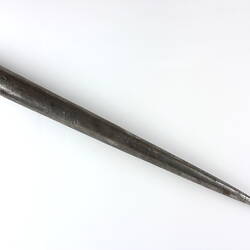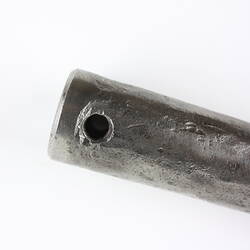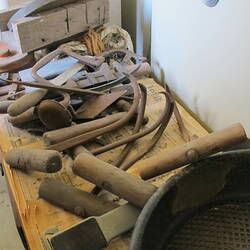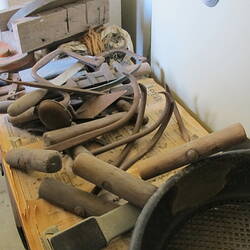Summary
Metal fid, used by stevedore James Farr Saunders (1888-1974). According to the donor contact, the fid was used to remove mooring ropes wrapped around bollards. They were often under tension as the ship moved in the water, so the fids had to be used with considerable force. The hole was threaded with cord to tether the fid - working by the water always required tethered tools, she explained.
James was a stevedore between about 1910 and 1960, working on the Melbourne docks, notably Station Pier, where he unloaded ships including those carrying post-war immigrants (he occasionally took a punt across the river to work at other docks). He was a member of the Port Phillip Stevedores Association and later the Waterside Workers' Federation, and participated in strike action. Documents relating to his union activity survive, including his ticket and stop work record, stored in his bedside drawer. Throughout his working life and especially during the strikes on the waterfront, the family was dependant on the vegetables, fruit trees and chickens in their backyard. James' denim jackets or dungarees, worn for his stevedore work, have also survived, showing extensive wear, mending and button replacements. Five hooks reflect his work on the docks, likely used for picking up bales.
Part of a collection of objects, documents and photographs from the Saunders family home in Williamstown Road, Port Melbourne. Elizabeth Jane Taylor Saunders (nee Elliott) (1894-1971) and James (Jimmy) Farr Saunders (1888-1974) bought the house in 1928, financed by the State Savings Bank of Victoria. James was a stevedore, working on the Melbourne docks; Elizabeth Jane was a skilled seamstress, making clothing for her family, mending, creating soft furnishings such as cushions and blankets, and doing decorative needlework. They had five children, of whom four survived to adulthood. After Elizabeth and James passed away their daughter Elizabeth Euphemia, a dental nurse and later language teacher, became the sole occupant of the house, carefully preserving its contents as decades passed.
Physical Description
Heavy cast iron fid with hole at narrow end.
More Information
-
Collecting Areas
-
User
James ( Jimmy) F. Saunders, Port Melbourne, Greater Melbourne, Victoria, Australia, circa 1910-1960
-
Classification
-
Category
-
Discipline
-
Type of item
-
Keywords
Waterside Workers, Shipping Industry, Knots & Splicing Equipment, Tools







